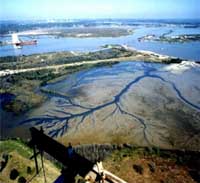|
Restoration in Galveston Bay, Texas
 |
|
Board walk constructed over restored tidal wetlands
|
On July 28, 1990, approximately 694,000 gallons of catalytic feedstock (a type of oil) was released into the Houston Ship Channel/Galveston Bay from two barges that were struck by a passing tanker.
The National Oceanic and Atmospheric Administration (NOAA) and natural resource trustee partners, including Texas Commission on Environmental Quality, Texas Parks & Wildlife, Texas General Land Office, and U.S. Fish and Wildlife Service, worked together to assess different areas of injury from the release:
- Finfish and shellfish losses as a direct result of exposure to oil
- Lost use of Galveston Bay fisheries due to spill-related fishery closures
- Injury to salt marshes coated by oil
 |
|
Dredge material loading into Cell One
|
After deteremining the degree of injury to these resources and their use, a Damage Assessment Restoration Plan for the spill was developed and finalized in May 1997. Four restoration projects were selected. One of the selected restoration projects created approximately 31 acres of estuarine emergent wetlands in San Jacinto Monument State Park, and involved installing temporary water control structures, filling the subsided area with dredged material, and planting smooth cordgrass. These changes will improve habitat conditions for estuarine-dependent species.
The project highlights what can be accomplished when federal, state, and private interests come together to preserve a unique resource. Thanks to the success of the marsh project, plans are already underway for restoration and enhancement of hundreds of acres of coastal tallgrass prairie and bottomland hardwood forest within the San Jacinto Monument State Park.
 |
|
Dredged material being placed in San Jacinto Monument State Park in late 1998.
|
This project, in combination with an elevated interpretive marsh trail, received the 2004 Coastal America Federal Partnership Award.
In southeastern coastal Texas there are many areas in need of restoration where projects like this one, emphasizing beneficial reuse of dredge materials and partnerships, could be constructed. NOAA, working with our co-trustees, continues to look for partnership opportunities.
In general, clean-up of oil spills and industrial facilities creates an ideal opportunity for combining response and remediation with restoration. Such projects carry maximum benefit by providing significant improvements to natural resources at a reduced expenditure of time and money. The trustees and the public can benefit from an accelerated investigation that allows faster cleanup and earlier restoration of injured resources.
For more information on this project:
|
|
|
|


